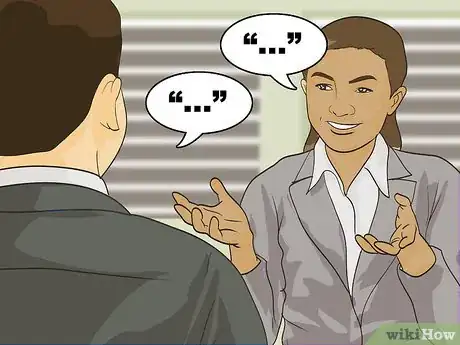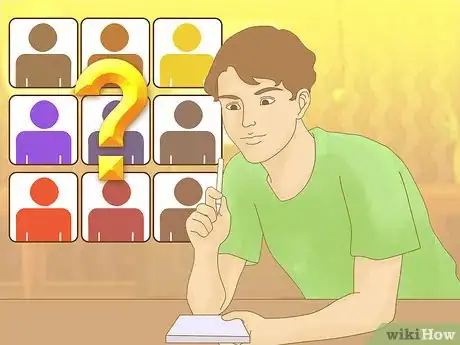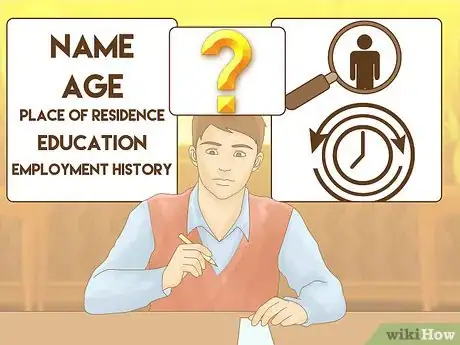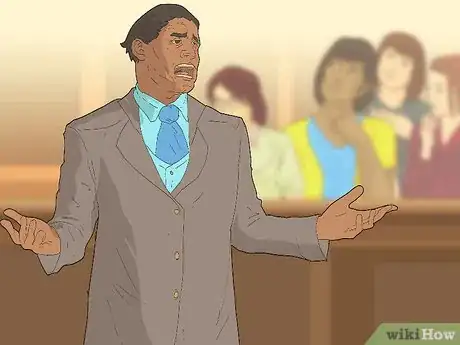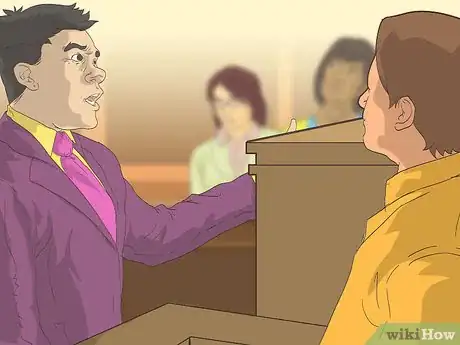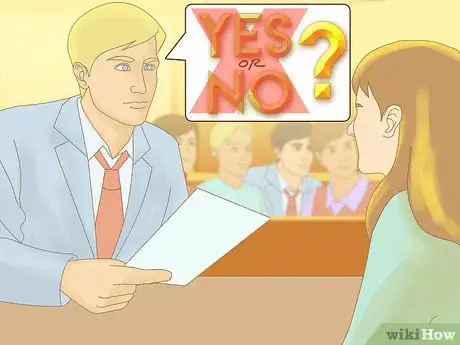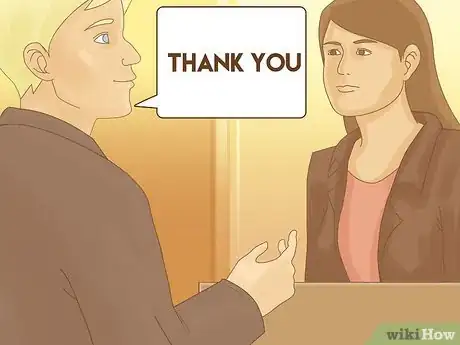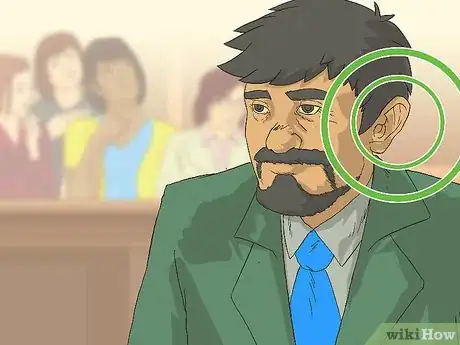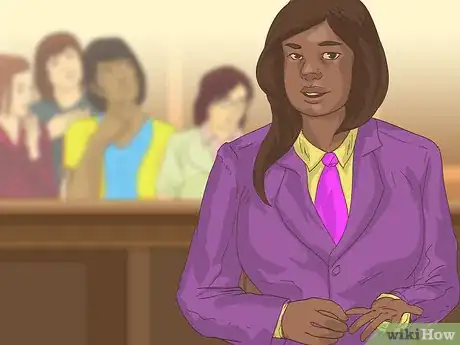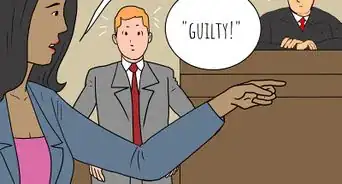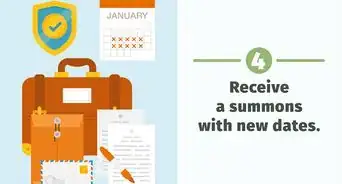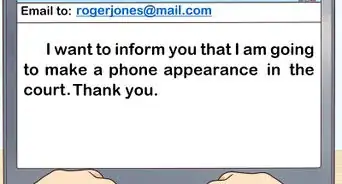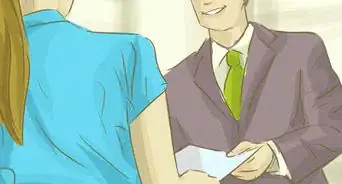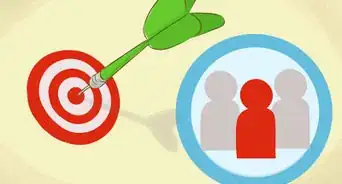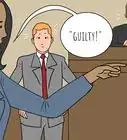X
This article was co-authored by Clinton M. Sandvick, JD, PhD. Clinton M. Sandvick worked as a civil litigator in California for over 7 years. He received his JD from the University of Wisconsin-Madison in 1998 and his PhD in American History from the University of Oregon in 2013.
This article has been viewed 35,949 times.
If you are representing yourself in court, then you need to prepare to ask witnesses questions. You can prepare by drafting a list of questions and then doing a practice run with your witness. Your approach to asking questions will differ depending on whether you are questioning your own witnesses on direct or cross-examining your opponent’s witnesses.
Steps
Part 1
Part 1 of 3:
Drafting Questions
-
1Interview possible witnesses. Your first task is to identify possible witnesses whose testimony might benefit you. Then you need to interview them to find out precisely what they know.
- Think back to the incident that is at issue in your lawsuit. If you were in a car accident, for example, identify the people who saw the accident. This group could include passengers in your car, bystanders, or passengers in the other car.
- Get a copy of the police report and read it. Witnesses might be identified in the report.
- Reach out to the witness and ask if they can meet you. When you meet, take a notepad and jot down what the witness remembers about the incident.
-
2Choose your witnesses carefully. You want people to testify if they can help prove your version of events. Witnesses must have first-hand knowledge of whatever it is they testify to.[1]
- For example, you might have gotten in a traffic accident. You want a witness to testify that you were not speeding. You could have a passenger in the car testify for you because the passenger has first-hand knowledge of how fast you were going.
- By contrast, you can’t have someone testify to what they heard. For example, your mother can’t testify that you told her over the phone that you weren’t speeding.
Advertisement -
3Outline questions. You should come up with an outline of questions to ask each witness. You can revise the outline, but using an outline will help you remember everything. For example, you can outline questions for one of your witnesses in the following way:
- Background information. You should start with basic information about the witness: name, age, place of residence, education, and employment history.
- Any weaknesses. You should anticipate how the other side will cross-examine your witnesses. For example, if your witness has a felony conviction, then the other side might use that information to discredit the witness. You can ask about it first. In this way, you can take the “sting” out of the revelation.
- What the witness knows. You then should get to the substance of the testimony: what the witness knows and how. For example, you will establish where the witness was and how she got there. Then you can ask what she saw or heard. You should ask the witness what she did in chronological order, since that is easiest to follow.
-
4Learn important objections. When you are examining witnesses, the other side can object to any question that you ask. Alternatively, you can also raise objections when the other side is asking questions. Once evidence is given to the judge, it is part of the official court record, and the judge can consider it when deciding your case. A successful objection will keep evidence from entering the record. This means the judge or jury cannot use that evidence to decide your case. You should learn some basic objections before trial by stating "Objection!" followed by one of the following reasons:[2]
- The question is compound. This means that you are really asking two questions in one. Respond by breaking up the question.
- Lack of personal knowledge. You are asking the witness to testify to things he didn’t personally observe.
- Hearsay. Hearsay is an objection to the witness’s lack of personal knowledge. With hearsay, a witness might repeat an out-of-court statement in order to prove the fact asserted in the statement. For example, a witness might say, “My sister told me you were speeding.” This statement is offered to prove you were speeding. You must be careful when objecting to hearsay because the opposing party will defend the question they asked.
- Asked and Answered. You should ask a question only once. However, if you don’t get a clear answer, then you can slightly rephrase the question to elicit a clearer answer from the witness.
- Misquoting the witness. Make sure that you listen closely to what the witness actually testifies to. If you need clarification, then follow up with questions.
- Leading. Leading questions are not allowed when direct examining the witness, but they are appropriate for cross-examining witnesses. A leading question puts a suggested answer in the form of a question, for example, "The light was green right?" is a leading question. If you are directly examining a witness, you can get around this by asking "What color was the light?" because you aren't suggesting an answer.
-
5Prepare your witnesses. You should try to meet with your witnesses a few days before the trial and go over the questions you will ask them.[3] The purpose of this practice is to get the witness comfortable with the questions you will ask. You are not meeting to prepare the answers for the witness.
- Let the witness answer in his or her own words. You shouldn’t tell the witness what to say.
- However, if the witness is confused, then you can remind him or her of what was said when you interviewed them earlier.
- This practice is critical. You want to go into court knowing what the answer to each of your questions will be.[4] The worst thing at trial is to ask a question and not know how the witness will answer.
Advertisement
Part 2
Part 2 of 3:
Asking Questions on Direct Examination
-
1Call the witness. If you are the plaintiff, then you will call witnesses first for direct examination. If you are the defendant, then the plaintiff calls witnesses first and you cross-examine them. When it is your turn to call your witnesses, stand up and say, “Your Honor, I’d like to call as my first witness [insert name].”
-
2Establish the witness foundation. The first thing you must do is establish that the witness has personal knowledge of what he or she is about to testify to. This means that the witness actually observed what they are testifying about.[5]
- You can establish this by asking open-ended “who, what, where, when, and why” questions.[6]
For example, if you want a witness to testify that she was in your car during an accident, you would ask a series of general questions without putting words in her mouth:
- “Can you state your name?”
- “Do you know the defendant?”
- “How do you know the defendant?”
- “Where were you on June 15, 2014?”
- “Why were you there?”
- “Did anything happen that you remember that day?”
- You can establish this by asking open-ended “who, what, where, when, and why” questions.[6]
For example, if you want a witness to testify that she was in your car during an accident, you would ask a series of general questions without putting words in her mouth:
-
3Don’t ask leading questions. A leading question is one that contains its own answer. Leading questions can usually be answered by “yes” or “no.” Unfortunately, you generally cannot ask your own witnesses leading questions.[7]
- For example, “You were a passenger in the defendant’s car on June 15, 2014, correct?” is a leading question. You are basically prompting the witness to say, “Yes.”
- Instead of asking leading questions, ask a series of open-ended questions, like those stated above.
-
4Listen to the answers. Even if you do a trial run with your witnesses, you should still listen closely to how they answer. Some witnesses might tell slightly different stories on the witness stand than they did when you first met them. Listen closely and try to correct any misstatements.
- The witness might tell a completely different story on the witness stand. In this situation, the witness probably has lied to you outside court. Once on the witness stand after taking an oath, he or she is telling the truth.
- If this happens, you should end the questioning as soon as possible. It probably won’t happen, but you should be prepared in case it does.
-
5Refresh a witness’s memory. You are typically allowed to refresh a witness’s recollection by showing them a document. If the witness expresses confusion or says, “I don’t know,” then ask the witness, “Would looking at [insert document] help refresh your memory?” After the witness says yes, you can tell the judge what document you are going to show the witness.
- The other side might want to look at the document, so be prepared to show it to them first before giving it to the witness.
- Only give the witness as much of the document as necessary to refresh their memory. For example, if they gave 20 pages of testimony in a deposition, then you don’t need to hand over the whole 20 pages. Show them the page with the relevant information.
- Once you give the witness the document, you can’t stand over their shoulder and instruct them what to read. Instead, you need to let the witness read the document. When the witness finishes, you can ask, “Did that refresh your memory?” If it did, you then take the document back before asking the witness questions.
-
6Thank the witness. When you are finished asking questions, say, “I have nothing further, Your Honor.” Then look at the witness and say, “Thank you.”
- Before telling the judge that you are done, be sure to look at your outline and make sure that you have covered everything you wanted to cover.
Advertisement
Part 3
Part 3 of 3:
Cross-Examining Witnesses
-
1Undermine the witness’s credibility. A person with damaged credibility is not a believable witness. One way to effectively cross-examine a witness is to challenge the witness’s credibility. You can do this in a couple of ways.
- Show bias. A witness might have an incentive to lie. You can create that impression by teasing out the witness’s relationship with the other party. For example, the witness might be related to the other party. They also could be business associates.
- Show contradictory statements. The witness might have made contradictory statements in a deposition or at an earlier trial. You can confront the witness with those statements.
- Ask about felony convictions. In some situations, you can undermine a witness’s credibility by introducing evidence that a witness has been convicted of a felony. You can also ask about a conviction for perjury.
-
2Show gaps in the witness’s testimony. An effective strategy is to ask the witness everything he or she doesn’t know about the case. By using this strategy, you emphasize how little relevant information the witness actually has to offer.
- For example, if you were in a car accident, a witness standing on the sidewalk might claim that you didn’t brake before hitting the other car. You can ask a series of questions about what the witness didn’t see:
- “You couldn’t see the taillights, could you?”
- “You don’t know how fast the car was going, did you?”
- “Was the car going 45 miles per hour?” “55 miles per hour?”
- “You couldn’t see the defendant’s foot inside the car, right?” “So you don’t know if he was pressing on the brake.”
- For example, if you were in a car accident, a witness standing on the sidewalk might claim that you didn’t brake before hitting the other car. You can ask a series of questions about what the witness didn’t see:
-
3Ask leading questions. You can ask leading questions on cross-examination.[8] Now is the time to lead the witness by asking questions which can be answered in a “yes” or “no” format.
- For example, you could ask a witness, “You were asleep in the car, weren’t you?”
-
4Repeat questions for the witness. When a witness gets upset or wants to avoid answering a question, he might ask you to repeat the question. He also might pretend not to understand it. You should always calmly repeat the question or rephrase it.
- Don’t get rattled. You should continue to rephrase the question. If you think the witness is being deliberately dense, then ask the judge to instruct the witness to answer.
-
5Remain polite. You should never get into a shouting match with the witness. Also avoid being snarky or sarcastic. Instead, remain polite and ask questions in a respectful manner.[9]
- Some witnesses might give you attitude. You need to smile in return. Remember that an angry witness comes across as non-credible to a jury and judge.
- If a witness refuses to answer a question, then ask the judge to instruct the witness to answer.[10]
Advertisement
References
- ↑ https://www.lsnjlaw.org/Courts/NJ-State-Courts/Superior-Court-of/Pages/Question-Your-Witness.aspx
- ↑ https://www.courts.ca.gov/partners/documents/WITNESSES.doc
- ↑ https://www.courts.ca.gov/partners/documents/WITNESSES.doc
- ↑ https://www.courts.ca.gov/partners/documents/WITNESSES.doc
- ↑ https://www.nolo.com/legal-encyclopedia/represent-yourself-court-faq-29087-6.html
- ↑ https://www.courts.ca.gov/partners/documents/WITNESSES.doc
- ↑ https://www.courts.ca.gov/partners/documents/WITNESSES.doc
- ↑ https://www.courts.ca.gov/partners/documents/WITNESSES.doc
- ↑ https://www.courts.ca.gov/partners/documents/WITNESSES.doc
About This Article
Advertisement
